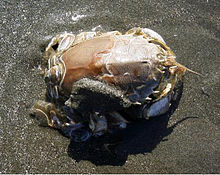- Hippoidea
-
Hippoidea
Temporal range: Maastrichtian–Recent
Blepharipoda occidentalis Scientific classification Kingdom: Animalia Phylum: Arthropoda Subphylum: Crustacea Class: Malacostraca Order: Decapoda Infraorder: Anomura Superfamily: Hippoidea
Latreille, 1825Families - Albuneidae
- Blepharipodidae
- Hippidae
Hippoidea is a superfamily of decapod crustaceans known as sand crabs or mole crabs.[1]
Ecology
Hippoids are adapted to burrowing into sandy beaches, a habit they share with raninid crabs, and the parallel evolution of the two groups is striking.[2] The whole body is almost ovoid, the first pereiopods have no claws, and the telson is long, none of which are seen in related groups.[3] Unlike most other decapods, sand crabs cannot walk; instead, they use their legs to dig into the sand.[4] Members of the family Hippidae beat their uropods to swim.[4]
Apart from the polar regions, hippoids can be found on beaches throughout the world. Larvae of one species have also been found in Antarctic waters, despite the lack of suitable sandy beaches in the Antarctic.[5]
Classification
Alongside hermit crabs and allies (Paguroidea), squat lobsters and allies (Galatheoidea) and the hairy stone crab (Lomis hirta, Lomisoidea), Hippoidea is one of the four groups that make up the infraorder Anomura.[6] Of the four, Hippoidea is thought to be the most basal, with the other three groups being more closely related to each other than to Hippoidea.[7]
The fossil record of sand crabs is sparse,[8] but extends back to the Cretaceous period.[2] Sand crabs are placed in three families († represents exclusively fossil taxa):[9][10]
- Albuneidae Stimpson, 1858
- Albunea Weber, 1795
- Austrolepidopa Efford & Haig, 1968
- Harryhausenia Boyko, 2004 †
- Italialbunea Boyko, 2002 †
- Lepidopa Stimpson, 1858
- Leucolepidopa Efford, 1969
- Paralbunea Serène, 1977
- Paraleucolepidopa Calado, 1996
- Praealbunea Fraaije, 2002 †
- Squillalbunea Boyko, 2002
- Stemonopa Efford & Haig, 1968
- Zygopa Holthuis, 1961
- Blepharipodidae Boyko, 2002
- Blepharipoda Randall, 1840
- Lophomastix Benedict, 1904
- Hippidae Latreille, 1825
- Emerita Scopoli, 1777
- Hippa Fabricius, 1787
- Mastigochirus Miers, 1878
References
- ^ Sunil Israel, T. Senthil Murugan, V. P. Venugopalan, T. Subramoniam, N. Munuswamy & G. van der Velde (2006). "Larval development in the sand crab, Emerita emeritus (L., 1767) (Anomura, Hippoidea) reared in the laboratory". Crustaceana 79 (4): 441–458. doi:10.1163/156854006777554857.
- ^ a b René H. B. Fraaije. "The first record of albuneid crabs (Crustacea, Decapoda) from the Cretaceous". Bulletin of the Mizunami Fossil Museum 29: 69–72. http://www.city.mizunami.gifu.jp/sightseeing/mizunami/cultural_property/institution/Bull29/BMFM29-069-072(116kB).pdf.
- ^ J. Maxwell, D. Cowles & H. Helmstetler (2006). "Key to Infraorder Anomura". Walla Walla University. http://www.wallawalla.edu/academics/departments/biology/rosario/inverts/Arthropoda/Crustacea/Malacostraca/Eumalacostraca/Eucarida/Decapoda/Anomura/Decapoda_Anomura__Key.html. Retrieved January 4, 2009.
- ^ a b Zen Faulkes & Dorothy H. Paul (February 1, 1997). "Digging in sand crabs (Decapoda, Anomura, Hippoidea): interleg coordination". Journal of Experimental Biology 200 (4): 793–805. PMID 9318562. http://jeb.biologists.org/cgi/content/abstract/200/4/793.
- ^ Sven Thatje & Veronica Fuentes (2003). "First record of anomuran and brachyuran larvae (Crustacea: Decapoda) from Antarctic waters". Polar Biology 26: 279–282. doi:10.1007/s00300-002-0476-6.
- ^ Joel W. Martin & George E. Davis (2001) (PDF). An Updated Classification of the Recent Crustacea. Natural History Museum of Los Angeles County. pp. 132. http://atiniui.nhm.org/pdfs/3839/3839.pdf.
- ^ Marcos Pérez-Losada, Carlos G. Jara, Georgina Bond-Buckup, Megan L. Porter & Keith A. Crandall (2002). "Phylogenetic position of the freshwater anomuran family Aeglidae". Journal of Crustacean Biology 22 (3): 670–676. doi:10.1651/0278-0372(2002)022[0670:PPOTFA]2.0.CO;2. http://biology.byu.edu/faculty/kac/crandall_lab/docsdata/pdf_files/2002/anomuran-2002.pdf.
- ^ Christopher B. Boyko (2004). "A new genus of fossil sand crab (Anomura: Albuneidae) from the Oligocene of Italy". Palaeontology 47 (4): 933–936. doi:10.1111/j.0031-0239.2004.00391.x.
- ^ Christopher B. Boyko (2002). "A worldwide revision of the Recent and fossil sand crabs of the Albuneidae Stimpson and Blepharipodidae, new family (Crustacea, Decapoda, Anomura, Hippoidea)". Bulletin of the American Museum of Natural History 272: 1–396. doi:10.1206/0003-0090(2002)272<0001:AWROTR>2.0.CO;2. http://digitallibrary.amnh.org/dspace/bitstream/2246/436/1/B272.pdf.
- ^ Sammy De Grave, N. Dean Pentcheff, Shane T. Ahyong et al. (2009). "A classification of living and fossil genera of decapod crustaceans". Raffles Bulletin of Zoology Suppl. 21: 1–109. http://rmbr.nus.edu.sg/rbz/biblio/s21/s21rbz1-109.pdf.
Categories:
Wikimedia Foundation. 2010.
